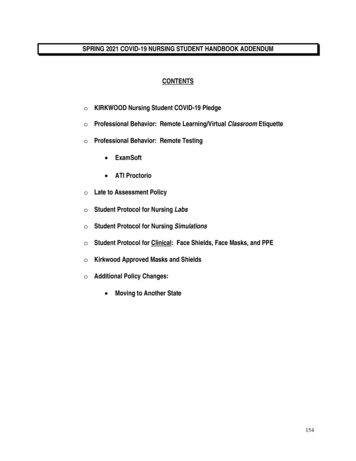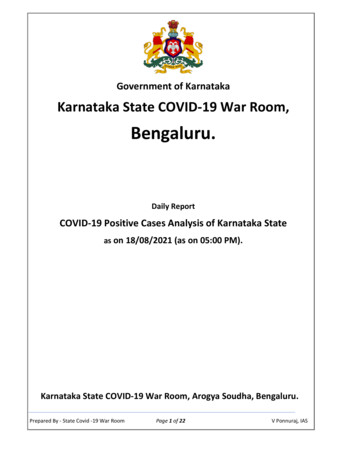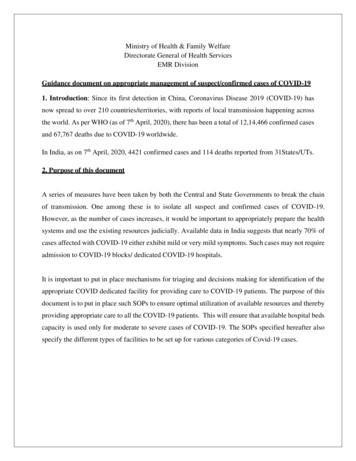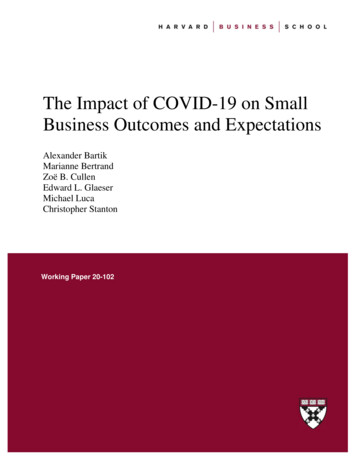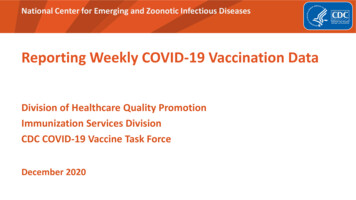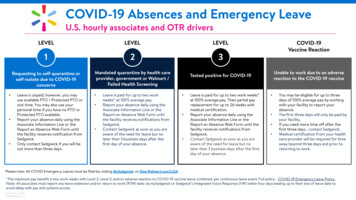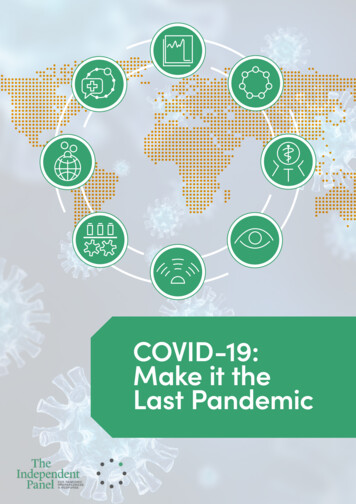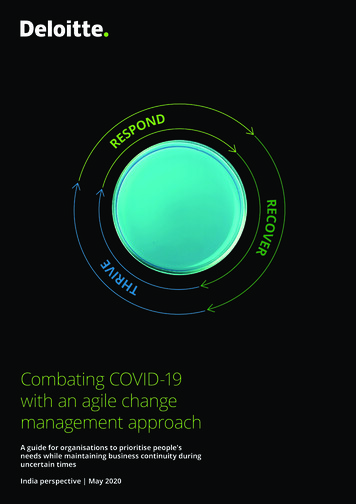
Transcription
Combating COVID-19with an agile changemanagement approachA guide for organisations to prioritise people'sneeds while maintaining business continuity duringuncertain timesIndia perspective May 2020
Combating COVID-19 with an agile change management approachContentsCOVID-19: Impact on people, operations,and businesses4Change management approach to navigatethrough COVID-195Resilient leadership in action6Central response office activation7Partnering with stakeholders8Communication on the go9Blended learning: The new focus10New digital ways of working11Respond, recover, and thrive213
Combating COVID-19 with an agile change management approachThe uncertainty brought on by COVID-19 requires organisationsto recognise leadership and employee sentiments and explorenew ways of working for business continuity.This perspective piece provides change management insightsand best practices to assist organisations in minimising theCOVID-19 impact on people, operations, and businesses.3
Combating COVID-19 with an agile change management approachCOVID-19: Impact on people,operations, and businessesCOVID-19 has been declared a pandemic; triggering a public health emergency worldwide. Its impact on people, their health,businesses, stock markets, and other pillars of the global economy needs no emphasis. The COVID-19 pandemic can be summarisedthrough the following facts: Rapid spread: The coronavirus, which first started in China and was reported in January, has quickly spread to more than 200countries1. Economic uncertainty: In early April 2020, the International Monetary Fund (IMF) said that they anticipate COVID-19 to be theworst economic fallout since the Great Depression2. Uncertainty around the pandemic: In the absence of any vaccination, the uncertainty around coronavirus is expected to remainhigh as cases continue to rise.To deal with the uncertainties and fight COVID-19, governments across the world have implemented various degrees of restrictions.For India, starting with a 21-day lockdown effective from 25 March 2020, the lockdown continues to extend with different terms andconditions with quarantine and social distancing emerging as the key solutions. In this spirit, barring essential services, allorganisations have mandated employees to work from home.Different people react differently to complexities and uncertainties, including feelings of loss of control, anxiety around well-being,and conjectures around financial insecurity. To help employees navigate through this turmoil, several organisations have madecounselling helplines and wellness sessions available to employees and their families.However, to tide through the situation there is a need for organisations and leadership to activate their businesscontinuity plans and consider employing an agile change management approach. These efforts have thepotential to help leaders transition their organisations to the required future state and also enable their people toadapt to the new working environment.We believe this document will help guide the enterprises to build organisational resilience and emerge stronger using a robustchange management approach. It will also address: How the leadership can manage expectations and prioritise the health and well-being of their workforce? How actions of a central response office can help manage stakeholders and communicate better (using tools to keep theworkforce informed and engaged, thereby creating a more resilient and agile workforce)? How a clear and consistent communication strategy can be established to keep all stakeholders informed and address theirconcerns? How new digital ways of working can be adopted? How a renewed focus on online learning strategies can be leveraged to engage and upskill employees?“Our job is obvious: We need to get out of the way, shine a light, and empowera new generation to teach itself and to go further and faster than anygeneration ever has.“- Seth Godin124WEF report, Countries where coronavirus has spread, March 2020Economic Times, IMF Report, April 2020
Combating COVID-19 with an agile change management approachChange management approach tonavigate through COVID-19This document offers a holistic change management approach, with best practices from varied sectors to address the shortterm need of surviving this unprecedented situation. It also looks at some long-term trends that this global phenomenon couldbring about and provides guidance on how to best prepare for it. This approach can be leveraged by organisations to strengthentheir workforce through resilient leadership, internal and external collaborations, and open and honest communicationsacross stakeholder groups.Resilientleadership inactionCentralresponse ationon the goBlendedlearning: Thenew focusNew digitalways ofworkingWorkforces across organisations are attempting to work through this change, while also solving for the change in their personallives. In doing so, most are undergoing a range of reactions as depicted by the “COVID-19 change curve“.Morale and emotionsDenialThis will not affect mycountry/organisation/myself?Frustration Virus is impactingmy world! Why do my professionaland personal plans haveto change?Depression How can I take care of my andmy family’s health and wellbeing? Will there be a job or salaryloss? Will there be a stoppage ofessential services? Will there be a slowdown inthe economy?Acceptance I understand COVID-19 realities I’m aware of process and policychanges in my organisation I can WFH and am empowered withtools/supportValley ofdespairCommitment I’m ready to invest timeand effort in learning I’m keen to servecommunities I’d like to innovate myways of workingTimeNote: Adapted from Kubler-Ross change curveOrganisations and leaders need to actively coach their workforces through the stages of the curve and pull them up from the “valleyof despair,” which is expected to have a deep impact on their morale and productivity.To do so, workforces need to be given ample information through their preferred modes of communication. In addition,appropriate and quick adjustments need to be made in the systems, processes, and structures to drive the whole organisationtowards “acceptance” and “commitment.”A few early adopters have already initiated efforts to support their employees and customers.An Indian multinational banking and financial services company has duplicated its online banking offerings onWhatsApp for retail customers. Customers can view their savings account balance, last three transactions, credit card limit,details of pre-approved instant loan offers, and block or unblock credit and debit cards securely, amongst others.5
Combating COVID-19 with an agile change management approachResilient leadership in actionLeading and inspiring employees amidst a global pandemic is only possible with compassion for workforces and communities.The need of the hour is for leadership to focus inside and then outside. This will enable them to lead from the heart and the mind.Leaders also need to align their approach with their actions to take the organisation through the crisis. This situation requiresclarity and decisiveness for embracing the challenge and managing the transition.As leaders attempt to respond, they must also place the safety of their employees at the core. In addition to the employees,it is crucial to identify all critical contributors to the business (such as customers, vendors, regulatory bodies, and partners) andensure their inclusion in the strategies to keep the workforce safe.Listed below are a few fundamental qualities of leaders from Indian organisations that are proving to be exemplarythrough the crisis:Skilledat triageDecisiveactionSeizing thenarrativeat theoutsetTo be able tostabilise theirorganisations tomeet the crisis athand while alsofinding opportunitiesamidst constraints.To be able to take decisionswith courage based onimperfect information. Leadersneed to take quick actions toensure physical, emotional,and financial security for theworkforce and communities.To be transparentabout current realities(including what theydon’t know) while alsopainting a compellingpicture of the futurethat inspires others.EmpathyTo be able to putthemselves in theshoes of employees,customers, and theirbroader ecosystems andconsistently connect andcommunicate with them.A US-based multinational corporation that provides IT services including digital, technology, consulting, and operationalservices has decided to pay about two-thirds of its employees in India an additional 25 percent of their base salary for themonth of April. This is being done as a “sign of gratitude” for their efforts in continuing to work during the COVID-19 crisis.The colossal scale of the outbreak and its sheer uncertainty makes it challenging for executives to respond. Organisations look up totheir leaders for guidance on tackling the strategic, operational, legal, and logistical challenges in the crisis. The checklist belowcan facilitate leaders to enable organisational survival and resilience through quick action:Respond with a people-first mindset.Build a cross-functional central response team with experts from functions such as IT, Admin, HR, Legal, Media andCommunications, Finance and Operations.Develop crisis-response strategy keeping all stakeholders in perspective.Activate business continuity plans and disaster recovery mechanisms.Assess and procure IT tools and infrastructure such as laptops, data cards, VPN, and firewalls to meet requirements.Assess mission-critical tasks and defer or deprioritise other non-essential projects. Allow well thought out cuts indiscretionary spends to maintain a healthy cash flow.Review performance metrics to align it with business and technology strategies. Also, regularly review the status ofengagement metrics to continuously improve the new digital workplace in action.Prepare temporary succession plans for key executive positions and critical roles.6
Combating COVID-19 with an agile change management approachCentral response office activationIn an unprecedented crisis characterised by uncertainty, leaders should immediately establish a cross-functional team to develop acoordinated response effort.The central response office (CRO) is multidisciplinary and comprises various functions. They are designed to act and adapt asteams familiarise with the crisis and as conditions change. Daily stand-ups of this cross-functional team can help guide executiveson where to focus their efforts, and be the integrated pulse for employees, customers, vendors, and partners.The CRO must also identify gaps and strengthen core capacities in surveillance, extend support to resources, logistics, andmitigate risks. To manage the current situation, the first task at hand is creating a collaborative, open, and inclusive virtualwork environment.FinanceMedia and CommunicationLegalBU leadsITAdminHRCROThe above mentioned teams come together to respond to the concerns of employees andformulate solutions for them.The key CRO responsibilities can be summarised as follows: Drive consistent messaging across the organisation—the single source of truth for all. Manage multi-channel communication including confidential feedback and reporting channels. Share updates on the latest public advisories from the local, state, and national political leaders and health officials fororganisational leaders to align on scenarios and actions required. Be at the center of all remedial actions across all work streams based on scenarios and triggers. Coordinate with the functionsand act fast. Set the governance to enable cross-functional teams to work together. Evaluate any changes in the ways of working owing to the Business Continuity Planning (BCP) scenarios and communicateacceptable ways of working clearly. Provide consistent guidelines to managers to ensure employees safety and engage them.While the leadership is aligned on the way forward and the CRO is activated to drive the organisation through the emergency, a taskforce also needs to be set up for forecasting and planning with a mid-to long-term view. It should also look at opportunitiesfor the business to innovate its operating model by leveraging new and digital ways of working. In this situation, it is essential toproactively engage and communicate with all stakeholders and bring them up to speed on a regular basis.A US-based global corporation that provides print and digital products and services in more than 160 countriesestablished a COVID-19 response team. The team meets regularly to monitor developments and guidances from governmentsand public health organisations. Educating all employees about the virus; Encouraging employees to work from home if they can; Sharing resources and guidance on how to contain the illness; Increasing and expanding cleaning of facilities; Restricting business travel and events; Establishing a comprehensive visitor screening process.7
Combating COVID-19 with an agile change management approachPartnering with stakeholdersIdentifying stakeholders (including staff, suppliers, customers, lenders, board of directors, investors, government agencies, and themedia) is critical to minimise the negative impact, maintain control, and secure the support of the organisation to move forwardquickly and convey confidence. Identifying and partnering with stakeholders is mission critical for organisations, given that the toppriority at the moment is to protect people and find new ways to serve customers.Equally important is to research ways to reach out to and collaborate with stakeholders leveraging alternative channels andonline tools.To achieve this, it is critical to collaborate internally with various business units by updating them on the business continuityplans to have one source of truth for employees, customers, regulatory bodies, and partners. This is also the time for theleadership to look up to the board for governance and for guidance to confront the uncertainty at hand.In these times, it is even more critical to be in touch with clients who may also have customers of their own. The messagecommunicated to them may reach an even greater audience. In addition, it is important to evaluate how they can be supported inthis time and agree on new ways of partnering. This is likely to forge even stronger relationships.Telecom companies such as Reliance Jio, Vodafone, Airtel, and BSNL have come forward to provide relief to theircustomers. They have extended the validity of their prepaid plans and also credited some talk time amount in the accountsof the low-income customers.An India-based telecom operator launched an initiative to help digitally unconnected customers remain connected duringthe current times. The programme enables every customer to recharge for a friend, family, or anyone who is unaware ordoes not have access to the internet. This good deed is rewarded with a cashback of up to 6 percent on recharges done by anexisting customer.Unionised employers need to collaborate with their union leadership to address concerns. Collaborating with and supportingcontractors and vendors is also critical. They are the extended workforce in most organisations and their well-being and securityneed to be on the organisation’s radar.Organisations can leverage the guidance below to partner with stakeholders and respond to their needs:8Identify stakeholdersUnderstand the effect of COVID-19on employees and partners of thesupporting organisations.Provide supportProvide direct support to employees/contractors that are severely impacteddue to the pandemic.Develop solutionsCreate tailored solutions to helpresolve specific needs of eachimpacted group.Deloitte has set up helplinesfor employees and their familiesto communicate any challengesarising from the pandemic andalso report any encounterswith suspected or confirmedcases. At senior levels, there areregular connects with clients andcustomers to help them navigatethese times.A premier real estate developerhas taken up the responsibilityto ensure that sufficient foodsupply arrangements are in placefor tens of thousands of workerswho are currently staying at theirsites. The group is also ensuringtheir medical welfare.One of the largest online fooddelivery platforms has arrangedan awareness drive for theirdelivery partners. Additionally,the company is providing themwith free medical consultationthrough partners. Plus, in caseswhere delivery associates have toself-quarantine, the organisationsupports them financially.
Combating COVID-19 with an agile change management approachCommunication on the goEmployees are likely to be exposed to conflicting information and feel anxious or confused about the best course of action.Organisations need to have a clear and focused approach to connect with their workforce to effectively lead them during periodsof uncertainty.An inclusive communication strategy for COVID-19 needs to be put into immediate action, based on a clear understandingof audiences (internal/external), message to be communicated, and frequency and channels of communication (digital/print). Forinstance, essential service industries are communicating with factory workers through verbal communications and print media.Also, note that the most important stakeholders in the communication plan are the leaders, therefore they need to beequipped and prepared to have conversations with the people, partners, clients, and other stakeholders.Some COVID-19 specific communication practices that can be leveraged include the following:For internal stakeholdersFor external stakeholders Encourage the regular use of digital tools to connectvirtually, formally, and informally. Be sure to clearly communicate HR policies aroundmedical and health insurance, leaves, absenteeism, loansagainst salaries, etc. Educate employees about COVID-19 symptoms andways of prevention. Issue specific travel-and immigration-relatedcommunication. Inform employees about the available IT infrastructure,tools, and support to enable seamless remote working. Communicate the new acceptable ways of working(timing, flexibility, etc.). Create channels for expressing emotions and concernsin a healthy way. Structure macro and micro customer messagingon business response and the possible impact oncustomers. Create or enhance external support channels tomanage and overcome temporary disruptions. Maintain regular check points with customers acrosslevels for collaborative problem solving.Numerous digital platforms are available in the marketplace that enable collaboration, networking, andcommunication on virtual platforms. Below are some examples of digital communication tools: Companies such as Zoom/Skype/WebEx provide remote conferencing services that combine video conferencing,online meetings, chat, and mobile collaboration. Enterprise social networking services such as Yammer/HumHub can be used for private communication withinorganisations. Unified communication and collaboration platforms such as Slack/Microsoft Teams combine workplace chat,video meetings, white boarding, file storage, and application integration.While virtual collaboration can be brought to reality with digital tools, employees will have to be empowered withsupport and information on well-being. Below listed initiatives can help employees sail through high degree of uncertainty anddisorientation. Consider a dedicated hotline for inquiries from employees. Consider bringing in medical experts to facilitate Q&A sessions with teams to stay aware and safe during this time. An intranet page that can be a dedicated one-stop solution for information, FAQs, previous communications, policies, and pointsof contact.9
Combating COVID-19 with an agile change management approachBlended learning: The new focusTraining is critical for fully realising business change. Amidst the lockdown, employees across levels and functions are bound to havemore time on hand. Organisations are looking at this downtime as an opportunity to upskill their workforce, and ensure thatthey have the knowledge, skills, and abilities to meet future demands—strengthening the effectiveness and productivity of the entireorganisation. An effective learning strategy and plan along with a virtual training platform can help prepare the workforcefor uncertainties of the future.Promote and enhance digital learningIn India, where travel restrictions and work-from-home policies have been in place for a few weeks now, organisations are looking toembrace digitally enabled experiences that could help add more value and create benefits for its stakeholders.For leaders, this opens up opportunities to promote existing digitally enabled offerings of learning to benefit the workforceduring challenging times. Direct communications reminding employees that learning does not have to stop when travel is truncated,may enhance attention towards available digital offerings.A few trainings that organisations can focus on are:LeadershipWorkforce Leadership in the times of disruption Leading virtual teams Role-based and process-based trainingsCybersecurity awareness training refresherAdopting the new normal—virtual work cultureWelfare and wellness sessionsOrganisational policy refresh (session on leaves, medical benefits, and care-giver)Organisations should focus on learning programs with a mix of e-learning modules, simulations, videos, socialcollaboration tools and podcasts. Many MOOC (Massive Open Online Courses) platforms such as Courseraand Udemy and start-ups including Byju’s, Vedantu and Toppr are offering online courses for free. Ivy leagueuniversities also have their own MOOC platforms that can be accessed through their website or using aggregatorssuch as iTunes U, University of the People, and YouTube.Deloitte on Cura Online LearningSocially distanced, virtually connectedDeloitte launched Cura, a digitally enabled learning platform that helps workforces build on their strengths and empowersthem with breakthrough content in a digital environment. It has specially curated pathways for workforces to learn aboutemerging technologies, build key skills, and take ownership of their development.10
Combating COVID-19 with an agile change management approachNew digital ways of workingVirtual interactions, team conversations, and collaborations have become the new normal. A combination of technologies and toolsto support remote work such as VPN infrastructure, access control mechanisms, and data security must be made available.In addition, policies, procedures, and trainings need to be in place to support organisation-wide remote work deployment. This willthereby reduce the risks of misalignment and lack of collaboration that arise from virtual teaming.It is therefore imperative for leaders to adopt agile working principles. To help them become effective in a remote environment,here are a few considerations:Deploy an effective BCP plan and set up explicit expectations to emulate business as usual.Establish regular cadence for check-ins with the top management.Establish a cross-functional system to drive collaboration.Encourage middle management to have regular check-ins with their teams over calls.Acknowledge the risk for change in performance.Ensure robust compliance and governance are in place to ensure security of client/organisation data.Deloitte has been using numerous technology tools for collaboration to: Hold virtual meetings, video conferences including town halls using online polling platforms to engage employees withreal-time voting. Leverage virtual workspaces white boarding functionalities to encourage collaboration and brainstorming.People managers have a challenging task to manage their workforce remotely. Under the new ways of working, the managementmight want to consider the following best practices:Show trust in your employees—avoid micromanagement.Relax the rules on business hours.Define governance processes, metrics, and oversight processes.Maintain a shared summary of tasks. Soften deadlines for work that is not business critical.Share WFH tips and tricks through mails or online team connects.Continue internal communication check-in frequently.For work that cannot be made remote, evaluate safeguards that can be put in place, such as revised cleaning protocols,employee rotation, or personal protective equipment for employee safety.Review (and update, if required) HR policies such as flexibility at work, absenteeism, sick leave, caregiver leave, and leaveof absence.Utility and essential service providers have been devising people-first strategies (such as reducing the number of shifts,rotating people in different shifts for better social distancing, making sanitisers, face masks, and medicines availableat all sites, as well as extending the hardship allowances and life/medical insurances) to maintain business continuityand support the community.11
Combating COVID-19 with an agile change management approachIn these testing times, we must support our teams withempathy and optimism. This will foster the team’s focus onwhat can be controlled as opposed to being consumed bythe chaos. This act alone can make a world of difference.12
Combating COVID-19 with an agile change management approachRespond, recover, and thriveChanges in the business models, new ways of working, along with the digital culture mindset which has emerged inorganisations’ response to the current situation are likely to stay post COVID-19 and have the potential to become mainstream. Inthe short term, putting people first with a clear strategy and plan focused on survival is essential to lead workforces effectively.Additionally, the situation at hand has pushed the opportunity on organisations and leaders to ponder upon subjects such ascorporate social innovation and employee wellness. Many organisations have quickly scaled up their corporate social innovationstrategies to help society.An Indian multinational steel manufacturer launched a ten-point #CombatCovid19 programme to empathise, empower,and equip communities. In one such programme, about 100 quintals of produce from 70 farmers has been earmarked andthe complete logistics chain mapped.Historically, organisations have taken a step back during a crisis. However, as the role of business in society continues to evolve,businesses are rising to the challenge to promote a positive impact on society. Additionally, organisations are encouraging theiremployees to contribute towards the nation, thereby adding one more dimension "to promote mental and emotional wellness”.43,000 employees of a state-owned bank have voluntarily donated a day’s salary towards the PM-Cares Fund to fightCOVID-19.From encouraging overall wellness, to ensuring employees are financially secure during the outbreak, organisations across theglobe have stepped up to take the lead in response to the crisis. The time now is also to think about how to best prepare for theupcoming disruptions. It is recommended that the crisis management teams think ahead about how this situation could playout, including the duration of the recovery period. They should indulge in scenario planning and continue to evaluate organisationalstrategies and robust business continuity plans for each scenario.Regularly reviewing the workforce adoption status and engagement metrics is fundamental to understand the challenges ofintroducing remote ways of working in an organisation. This will enable leaders to find ways of overcoming these challenges andsustain digital ways of working.In the long term, with the advent of Industry 5.0, these new digital ways of working (telecommuting, virtual gatherings, on-demandeducation, just-in-case sourcing, agile IT and IT risks, and cyber security) that rely heavily on technology and virtual environmentenablement will continue to be a part of the new normal.COVID-19 may fundamentally challenge the organisational culture and the way work is distributed to and deployed by theworkforce. The key is to enable present workarounds and use them as an opportunity to shape the future ways of working withincreased interaction between man and machine for better efficiency, effectiveness, and collaboration.13
ContactsGaurav LahiriPartnergauravlahiri@deloitte.comAbhilasha Kataria ntsDeeksha SrivastavaNishita BhasinNikita SharmaDeloitte refers to one or more of Deloitte Touche Tohmatsu Limited, a UKprivate company limited by guarantee (DTTL), its network of member firms,and their related entities. DTTL and each of its member firms are legallyseparate and independent entities. DTTL (also referred to as “Deloitte Global”)does not provide services to clients. Please see www.deloitte.com/about for amore detailed description of DTTL and its member firms.This material has been prepared by Deloitte Touche Tohmatsu India LLP (DTTILLP), a member of Deloitte Touche Tohmatsu Limited, on a specific requestfrom you and contains proprietary and confidential information. This materialmay contain information sourced from publicly available information or otherthird party sources. DTTI LLP does not independently verify any such sourcesand is not responsible for any loss whatsoever caused due to reliance placedon information sourced from such sources. The information contained inthis material is intended solely for you. Any disclosure, copying or furtherdistribution of this material or its contents is strictly prohibited.Nothing in this material creates any contractual relationship between DTTI LLPand you. Any mutually binding legal obligations or rights may only be createdbetween you and DTTI LLP upon execution of a legally binding contract. Byusing this material and any information contained in it, the user accepts thisentire notice and terms of use. 2020 Deloitte Touche Tohmatsu India LLP. Member of Deloit
Combating COVID-19 with an agile change management approach 6 Resilient leadership in action Leading and inspiring employees amidst a global pandemic is only possible with compassion for workforces and communities. The need of the hour is for leadership to focus inside and then outside.T


